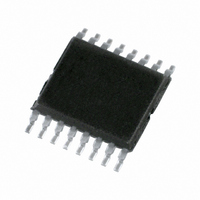SC16IS740IPW,112 NXP Semiconductors, SC16IS740IPW,112 Datasheet - Page 36

SC16IS740IPW,112
Manufacturer Part Number
SC16IS740IPW,112
Description
IC UART SINGLE W/FIFO 16-TSSOP
Manufacturer
NXP Semiconductors
Type
UART with 64-byte FIFOs and IrDA encoder/decoderr
Datasheet
1.SC16IS740IPW112.pdf
(62 pages)
Specifications of SC16IS740IPW,112
Number Of Channels
1, UART
Package / Case
16-TSSOP (0.173", 4.40mm Width)
Fifo's
64 Byte
Protocol
RS232, RS485
Voltage - Supply
2.5V, 3.3V, 5V
With Auto Flow Control
Yes
With False Start Bit Detection
Yes
With Modem Control
Yes
Mounting Type
Surface Mount
Data Rate
5 Mbps
Supply Voltage (max)
3.6 V
Supply Voltage (min)
2.3 V
Supply Current
6 mA
Maximum Operating Temperature
+ 85 C
Minimum Operating Temperature
- 40 C
Mounting Style
SMD/SMT
Operating Supply Voltage
2.5 V, 3.3 V
Lead Free Status / RoHS Status
Lead free / RoHS Compliant
For Use With
568-4000 - DEMO BOARD SPI/I2C TO DUAL UART568-3510 - DEMO BOARD SPI/I2C TO UART
Lead Free Status / Rohs Status
Lead free / RoHS Compliant
Other names
568-3648-5
935280988112
SC16IS740IPW
935280988112
SC16IS740IPW
Available stocks
Company
Part Number
Manufacturer
Quantity
Price
Company:
Part Number:
SC16IS740IPW,112
Manufacturer:
JAMICON
Quantity:
101
NXP Semiconductors
SC16IS740_750_760_6
Product data sheet
9.3.1 Normal multidrop mode
9.3.2 Auto address detection
9.2 RS-485 RTS output inversion
9.3 Auto RS-485
EFCR bit 5 reverses the polarity of the RTS pin if the UART is in auto RS-485 RTS mode.
When the transmitter has data to be sent it will deasserts the RTS pin (logic 1), and when
the last bit of the data has been sent out the transmitter asserts the RTS pin (logic 0).
EFCR bit 0 is used to enable the RS-485 mode (multidrop or 9-bit mode). In this mode of
operation, a ‘master’ station transmits an address character followed by data characters
for the addressed ‘slave’ stations. The slave stations examine the received data and
interrupt the controller if the received character is an address character (parity bit = 1).
To use the auto RS-485 mode the software would have to disable the hardware and
software flow control functions.
The 9-bit Mode in EFCR (bit 0) is enabled, but not Special Character Detect (EFR bit 5).
The receiver is set to Force Parity 0 (LCR[5:3] = 111) in order to detect address bytes.
With the receiver initially disabled, it ignores all the data bytes (parity bit = 0) until an
address byte is received (parity bit = 1). This address byte will cause the UART to set the
parity error. The UART will generate a line status interrupt (IER bit 2 must be set to ‘1’ at
this time), and at the same time puts this address byte in the RX FIFO. After the controller
examines the byte it must make a decision whether or not to enable the receiver; it should
enable the receiver if the address byte addresses its ID address, and must not enable the
receiver if the address byte does not address its ID address.
If the controller enables the receiver, the receiver will receive the subsequent data until
being disabled by the controller after the controller has received a complete message from
the ‘master’ station. If the controller does not disable the receiver after receiving a
message from the ‘master’ station, the receiver will generate a parity error upon receiving
another address byte. The controller then determines if the address byte addresses its ID
address, if it is not, the controller then can disable the receiver. If the address byte
addresses the ‘slave’ ID address, the controller take no further action, the receiver will
receive the subsequent data.
If Special Character Detect is enabled (EFR[5] is set and the XOFF2 register contains the
address byte) the receiver will try to detect an address byte that matches the programmed
character in the XOFF2 register. If the received byte is a data byte or an address byte that
does not match the programmed character in the XOFF2 register, the receiver will discard
these data. Upon receiving an address byte that matches the Xoff2 character, the receiver
will be automatically enabled if not already enabled, and the address character is pushed
into the RX FIFO along with the parity bit (in place of the parity error bit). The receiver also
generates a line status interrupt (IER[2] must be set to ‘1’ at this time). The receiver will
then receive the subsequent data from the ‘master’ station until being disabled by the
controller after having received a message from the ‘master’ station.
If another address byte is received and this address byte does not match Xoff2 character,
the receiver will be automatically disabled and the address byte is ignored. If the address
byte matches Xoff2 character, the receiver will put this byte in the RX FIFO along with the
parity bit in the parity error bit (LSR bit 2).
Single UART with I
Rev. 06 — 13 May 2008
2
C-bus/SPI interface, 64-byte FIFOs, IrDA SIR
SC16IS740/750/760
© NXP B.V. 2008. All rights reserved.
36 of 62
















